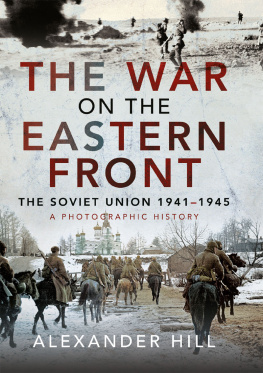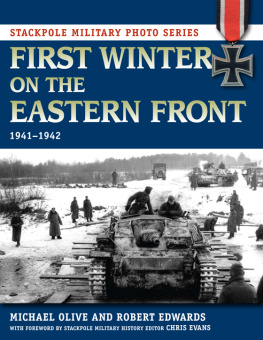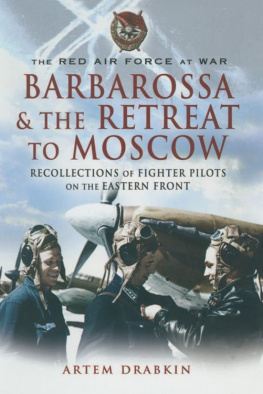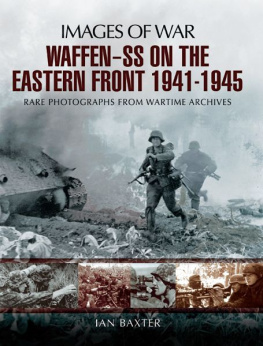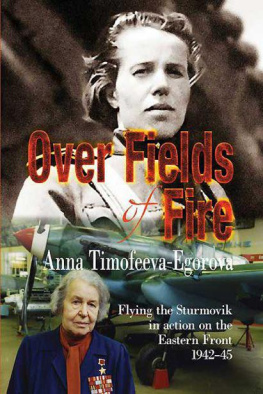
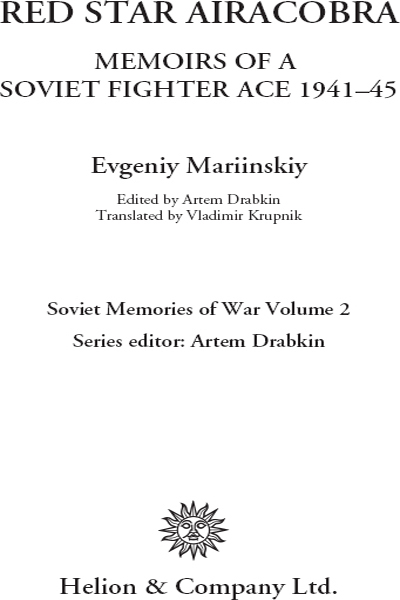
Dedicated to my comrades in arms
Helion & Company Limited
26 Willow Road
Solihull
West Midlands
B91 1UE
England
Tel. 0121 705 3393
Fax 0121 711 4075
Email: publishing@helion.co.uk
Website: http://www.helion.co.uk
Published by Helion & Company 2006
eBook edition 2011
Designed and typeset by Helion & Company Limited, Solihull, West Midlands
Cover designed by Bookcraft Limited, Stroud, Gloucestershire
Printed by Cromwell Press Ltd, Trowbridge, Wiltshire
Artem Drabkin and Evgeniy Mariinskiy 2006
Photographs personal archive of the Mariinskiy family
Text edited by Artem Drabkin, translated by Vladimir Krupnik.
Preface written by Mikhail Bykov, translated by Vladimir Starostin.
Publication made possible by the I Remember website (http://www.iremember.ru/index_e.htm) and its director, Artem Drabkin.
Hardcover ISBN 1 874622 78 7
Digital ISBN 9781907677540
British Library Cataloguing-in-Publication Data.
A catalogue record for this book is available from the British Library.
All rights reserved. No part of this publication may be reproduced, stored in a retrieval system, or transmitted, in any form, or by any means, electronic, mechanical, photocopying, recording or otherwise, without the express written consent of Helion & Company Limited.
For details of other military history titles published by Helion & Company Limited contact the above address, or visit our website: http://www.helion.co.uk.
We always welcome receiving book proposals from prospective authors.
Preface: The Regiment of Aces
T his book is about the men of a fighter regiment that followed in the footsteps of many similar fighter regiments formed just before the Great Patriotic War and disbanded soon after the end of this war. There were dozens of front-line regiments just like it that faithfully did their duty as soldiers. But this regiment without any special status became one of the most effective in the Soviet Air Forces: according to the official records its pilots brought down 546 enemy planes in aerial combat, killed hundreds of enemy soldiers and officers and destroyed dozens of pieces of combat equipment and vehicles on the ground. Ten pilots of this regiment received the rank of Hero of Soviet Union: one pilot received this award twice.
The 27th Fighter Regiment with four squadrons began to be formed in May 1938 in the Moscow Military District Air Force on the base of a separate special fighter squadron. The Regiment was equipped with I-14, I-15bis and I-16 fighters. Major Ivan Dmitrievich Klimov commanded the 27th FR from the moment of formation till June 1941.
In December 1939 two squadrons of the Regiment (3rd and 4th) were equipped with I-153 aircraft and directed to the Karelian Isthmus where they took part in the war against Finland. In view of the small number of Finnish aircraft, pilots of the 27th FR were mainly engaged in air-to-ground attacks. The Squadrons crews conducted 747 operational sorties and as a result of air strikes on the enemy front line destroyed, according to the Soviet data, 4 field guns, 3 antiaircraft batteries and up to 700 enemy soldiers and officers.
On 20 June 1941 the 27th FR with a 3-squadron structure joined the Moscow Air Defenses newly formed 6th Fighter Corps. Lieutenant-Colonel P.K.Demidov took charge of the Regiment. Before the beginning of the Great Patriotic War the Regiment was at the stage of rearming with new materil and had a double set of I16 and MiG-3 planes. 36 of the 53 pilots in the Regiment had already mastered a new fighter of Mikoyan and Gurevichs design.
In the summer of 1941 the Regiment became involved in the aerial defence of the capital from enemy air raids. In July the crews carried out operational sorties from the Kalinin airfield, then from an airfield in the town of Klin. Despite the complexities inevitably related to reequipment with new materil, the Regiment, which had not participated in the fierce frontier battles of the first month of the war, and was manned by skilled aircrew and technical personnel, managed to make a worthwhile contribution to the protection of Moscow from the first and most intensive strikes from German aircraft.
The fighting account of the Regiment was opened on 17 July 1941 by Senior Politruk (political officer) Desyatnichenko, who brought down (according to Soviet records) a German Ju-88 bomber whilst flying his MiG-3. During the first week of the Luftwaffe night strikes on Moscow (2229 July) 6 German bombers (all were identified as Ju-88) were assigned to the Regiments account and it is noteworthy that five of them fell victim to pilots flying I-16s. The reason for a ratio so unfavourable to the MiGs was that the pilots of the 27th FR had mastered night flights on new planes to an insufficient degree and the main load of work at nights was carried by the seasoned, tried and true workhorses: the I-16s.
The pilots of the Regiment also held undisputed pride of place in the development of the weapon of heroes aerial ramming (while not denying the real heroism of the Soviet pilots it is necessary to note that the rams were frequently a consequence of insufficient mastery of new equipment). The first night ram in history was carried out on 31 July 1941 by a squadron commander Senior Lieutenant Petr Vasilyevich Yeremeyev, who destroyed an enemy bomber. Above the village of Golovino, near Moscow, the Soviet pilot attacked a He-111 in his MiG-3 at 1.36 a.m. He expended all of his ammunition but the enemy plane continued flying. Then Yeremeyev approached the bomber from below and chopped off its stabilizer and control surface with his propeller. Then the enemy plane crashed. The crew commanded by Unteroffizier A. Tsarabek died. The Soviet pilot bailed out of his uncontrollable plane and landed by parachute. For this feat Petr Yeremeyev was awarded the Order of the Red Banner.
On August 11th, 1941 Lieutenant Alexey Katrich distinguished himself. At 9.30 a.m. he was flying a MiG-3 in a pair with Lieutenant Medvedev to intercept a Do-215 reconnaisance plane which was flying towards the Bologoye railway junction. Soon the engine of his wingmans plane overheated and Katrich continued the pursuit alone. Before reaching Bologoye the enemy turned around and went along the MoscowLeningrad railway. Katrich caught up with the German plane above Ostashkov at a height of about 8000m and from a distance of 100m opened fire from his machine guns, piercing the enemy plane with a long burst of fire from tail to engine. Katrich set ablaze one of the engines with his second burst and killed the gunner with his third one. The Soviet pilot intended to shoot at the cockpit to finish the enemy off but ran out of ammo. The Dornie continued its flight. Then Katrich decided to ram the enemy. He approached it at a narrow angle from the left and damaged the enemys stabilizer with the ends of the blades of his propeller. The German plane wavered, then fell over on its wing and went down. Soon it smashed into the ground near the village of Staritsa and burned up. The whole crew from 1/Aufkl.Gr. Ob.d.L. (the strategic reconnaissance aircraft group operated by the German Oberkommando ) led by Lieutenant R. Roeder was killed. Lieutenant Katrich safely landed on the airfield. This was the first high-altitude ram in the world history of military aviation.
By October 1941 the German Command had rejected the tactics of massed night strikes on Moscow and the pilots of 27th FR and all 6th AD Fighter Corps were assigned other tasks. The Germans approached close to the capital and the Soviet Army and national home guard barely restrained the Wehrmacht onslaught, allowing the German tactical air force to reach Moscow. Therefore aerial defense pilots were compelled to carry out tasks unusual for AD fighters to battle enemy fighters and to carry out bombing and strafing attacks on the approaching enemy. I-16 Donkeys again were very useful because their air-cooled engines could cope better with ground fire than the MiG motors which were more vulnerable, even to a rifle bullet. In addition, the pilots of the I-16s could better use the more powerful armament and better manoeuvrability of their planes when strafing.




